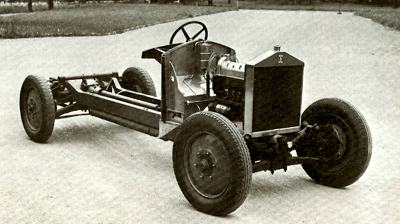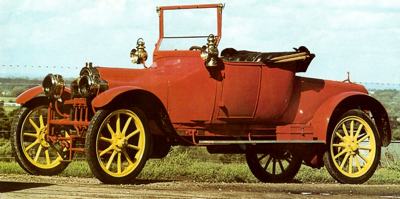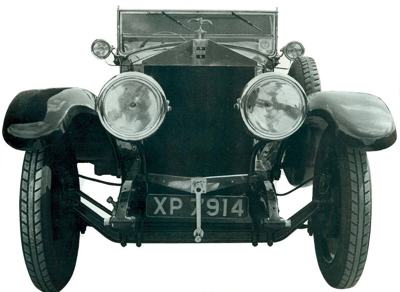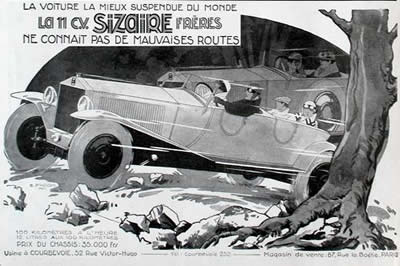Maurice Sizaire
Maurice Sizaire trained as an architect but, after seeing a steam tricycle (possibly an early De Dion Bouton) pass by the front of his home when he was only eight years old, Sizaire had harboured a secret ambition to build a self-propelled vehicle. In his early teens at the beginning of the 1890s he began experimenting in his bedroom workshop. He set himself the task of absorbing as much as he could of contemporary cycle and motor technology. He even persuaded his younger brother, Georges, to becoming a trainee turner in a bicycle factory, so that he might have help in realising his ambition.
In 1897 the brothers rented a tiny workshop in Puteaux, near Paris, where they began construction of a single-cylinder car with a tubular chassis and three-speed belt drive. Short of funds and working only in their spare time, the brothers progressed slowly, helped latterly by their friend Louis Naudin: the car was running by 1902, but the transmission was not a success. So Sizaire devised a novel form of gearing, on which three forward speeds were provided by a propeller shaft which could be shifted so that pinions of varying diameter were forced into engagement with the long-suffering crown-wheel.
The Exposition des Petits Inventeurs
It was, apparently, the first time that a car had been provided with three direct drives forward: another novelty was the use of independent front suspension by sliding pillars linked by a transverse leaf spring. In this form the car was complete by 1904, and was shown at the Exposition des Petits Inventeurs in March 1905, where its design attracted much attention: a company was formed for its production, and a stand taken at the 1905 Paris Salon.
Many orders were forthcoming for the Sizaire-Naudin light car, and by 1906, two cars a day were leaving the factory. But it had been priced too low, and the newly-formed company ran into financial difficulties; it was bought by the Due d'Uzes, who provided sufficient capital for the firm to indulge in some sporting activities as well as building private cars. First fruits of this new sporting policy was the entry of three cars in the original Coupe de I' Auto race in 1906 - and a victory by Georges Sizaire with a standard 1244 cc single-cylinder Sizaire in this somewhat unsatisfactory six-day event.
Toilet Break or Cylinder Change?
More significant was the marque's first place in the Coupe des Voiturettes run over the tortuous
Targa Florio course just before the Paris Salon of 1906, at an average speed of 21.7 miles per hour. A team of three long-stroke cars was specially built for the 1907 Coupe de l'Auto, with single-cylinder engines of 1178cc equipped with steel (instead of cast-iron) pistons, which began to develop cracks during the endurance run section of the event. So the drivers were forced, on one lap, to drive into a wood and remove the cylinder to change the pistons in secret: they still maintained the required average, and the timekeepers put the delay down to a call of nature: And by virtue of this pleasant subterfuge, Louis Naudin came first, followed by Georges Sizaire.
It seems as though the Sizaire-Naudin company was the first to realise that, though the regulations of the Coupe de I' Auto restricted the bore of a car, the length of the stroke was up to the manufacturer and his engineering ability, real or imagined. It was a widely copied ploy, yet the Sizaire-Naudin racers were never tall-bonneted freaks like the Lion-Peugeots. This first time out success with the long-stroke Sizaire-Naudin caused such consternation among the marque's racing rivals that they demanded an official examination of the cars' fuel ... and were duly non-plussed to find them burning ordinary petrol.
Sizaire-Naudin built its largest single-cylinder racing cars for the 1908 Coupe des Voiturette at Dieppe, with 1963cc power units developing a healthy 42 bhp. Unfortunately Naudin could manage no better than second place behind a Delage, having been delayed by a burst tire and a leaking petrol tank. The Sizaire-Naudin production cars were popular with the young bloods of the day, as they were one of the first cheap sports cars to offer a decent performance. Power output was progressively increased by lengthening the stroke. In mid 1908 the 9 hp, 1357cc Sizaire-Naudin was replaced by a new 12 hp model of 1470cc.
 1924/1925 Sizaire 2 liter chassis.
1924/1925 Sizaire 2 liter chassis.
 1913 Sizaire et Naudin four cylinder Ballot engined car.
1913 Sizaire et Naudin four cylinder Ballot engined car.
 1921 Sizaire-Berwick 25/50hp.
1921 Sizaire-Berwick 25/50hp.
 Sizaire Freres Type 4R1.
Sizaire Freres Type 4R1. |
Max Pemberton
The author and motoring journalist, Max Pemberton, was lent one of the first of these cars imported into England for an extended road test by the British agent, Charles Jarrott. He found the car 'as flexible as many a forty, and much handier.' Priced at £220, this Sizaire model was apparently selling faster than it could be imported, and Pemberton's experiences gave some of the reasons for this popularity. 'I had not driven a single-cylinder car for some time and I succeeded in stopping the engine once, but the Sizaire-Naudin is difficult to stop even by a bungler, and she can be driven down a country lane at ten miles an hour with no more effort (or considerably less) than is necessary to drive some "monsters" at fifteen. As for hills, I discovered nothing during a three-days' tour which brought her down from top.
You can pick your way through crowded traffic with her and accelerate instantly to thirty miles an hour to take an opening should the necessity arise. Perhaps it would not be wise to speak of what she will do on the level, but if there be any man so dead to all sense of veneration for the police as to desire a speed of forty miles an hour in the open, then I venture to say the Sizaire-Naudin will not disappoint him. 'Now these are facts established by a car of the standard pattern just over from France and in no way tuned up. The only point of criticism I could possibly make concerned the gear-changing, which on this particular chassis was not as smooth as it might have been; but then the whole gear system is so novel on a Sizaire and possesses such amazing ad vantages that it would be absurd to carp at trivialities. As a general rule these gears are to be changed quietly and pleasingly. I had an unlucky specimen which would have required an hour in the works to put right.'
The tractability of a Sizaire-Naudin was all the more surprising when you consider that the speed was controlled not by a throttle of the conventional pattern, but by a cam which varied the lift of the inlet valve, thus controlling the charge size. The popularity of these little cars was shown in 1908 when an all-Sizaire race was organised at
Brooklands. More significant was the French company's decision to opt out of racing after 1909, mainly because other companies with far greater resources were now coming into the voiturette racing field, making competition far keener, and races harder to win than in the period from 1906 to 1908.
A new touring Sizaire-Naudin appeared in 1909, this time with a 1583cc engine. This had a number of detail refinements, such as a new design of air inlet valve for the carburetor, which eliminated the characteristic jingling sounds which had formerly heralded the approach of all Sizaire cars. Another untoward noise was eliminated by the provision of ball-bearings at either end of the gear-shaft, which was claimed to make the gears wonderfully silent and to do away with the grinding sound which had previously emanated from the transmission on the over-run. The clutch spring was lightened, the throttle cam was improved, and a new pattern of radiator, giving greatly improved cooling, was standardised.
However, before long, the Due d'Uzes decided that the company was now on a sufficiently firm footing for him to dismiss Naudin and the two Sizaire brothers, even though they were under contract. The company had just introduced its first four-cylinder model, the 1847cc 12 hp. In 1913 the last of the single cylinder models appeared, a new 1357cc 10 hp, but the company was now tending to produce solid, respectable family cars and the sporting image waned as rapidly as the firm's fortunes. The Sizaire-Naudin company lasted until 1921, by which time its products had become very staid.
The Sizaire-Berwick
After the rift with the Due d'Uzes, Maurice and Georges Sizaire founded a new company in conjunction with F. W. Berwick, who was a motor agent dealing in French cars such as the La Licorne. Naudin, however, retired from work and died soon after. The new Sizaire-Berwick car, designed by Maurice Sizaire, was a well engineered, totally orthodox car, with a four-cylinder engine of 4072cc. The radiator was of similar design to that of the Rolls-Royce, a fact which eventually caused Rolls-Royce to take legal proceedings - which were settled out of court when it was discovered that Rolls-Royce had not registered the design and Sizaire-Berwick had. After that, the Sizaire-Berwick had a shallow radiator which was, if anything, more handsome than the Rolls cooler.
Sizaire-Berwick cars were initially built at Courbevoie, near Paris; one of the apprentices seconded to the factory from London was a young man named Jack Waters, who was later to achieve fame as the actor Jack Warner. Production was halted by World War 1, and the Sizaire brothers spent the duration in the army, while Berwick established a factory in London to build aircraft. After the hostilities, Maurice Sizaire moved to London to design a new Sizaire-Berwick car, but found his decisions were constantly overruled by the chief engineer of the company (who was related to the man who had put up the capital to establish the business). The new 25/30 hp, 4536cc, Sizaire-Berwick scaled almost two tons in chassis form thanks to the modifications made by this engineer in the interests of strength.
Materials were on hand to build 1000 cars, but it is highly unlikely that anything like this number was ever built. In 1923, the Austin Motor Company acquired Sizaire-Berwick, and the company's principal production in its declining years were re-radiatored Austins of 12 and 20 hp, though a six-cylinder 3.2 liter model was also available. Sizaire-Berwick were moribund by 1925, but Maurice Sizaire and his brother were working on a new model as early as 1920, for production at Courbevoie. Two prototypes were completed that year, which featured independent suspension all round.
The Sizaire Freres Type 4R1
When this model reached production status in 1923, it was the first all-independent car to be sold to the general public. The design followed the broad principles of the old voiturette front suspension, but was considerably refined. With a two-liter power unit, the standard Sizaire Freres Type 4R1 was capable of almost 70 mph in standard form, while there was also a I6 valve sports version, which went on sale in 1926. The company enjoyed considerable success with this model, but lacked finance to expand. The board of directors demanded exorbitant licence fees from companies interested in fitting the Sizaire suspension to their products, and only succeeded in frightening them all away.
Production ceased in France in 1929, although some cars were still being built in Belgium by Georges Sizaire until 1931. In I933 Maurice Sizaire joined the Tecalernit Company as an engineer and stayed with that company until 1960, when he retired at the age of 83 to devote himself to his hobby of painting.
